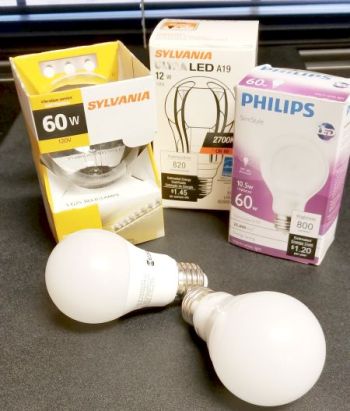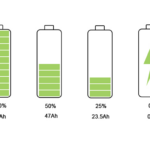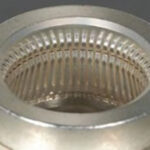Another myth busted: You needn’t worry about ultraviolet light coming from ordinary LED bulbs.
We recently checked a batch of LED bulbs for the amount of blue light they gave off. This effort came in response to claims from some in the alternative medicine crowd that LED bulbs gave off inordinate amounts of unhealthy blue light.
Perhaps to the disappointment of alternative medicine proponents, none of the LED bulbs we checked put out any more blue light than ordinary 60-W incandescent bulbs. But one reader came back at us with this comment:
White LEDs work by producing visible light as second emission. The semiconductor only produces UVC light at single wavelength, then a mixture of phosphore (SIC) adsorbs UVC and converts in to visible light of many wavelengths. The problem is in the UVC not being totally converted, thus partially emitted: UVC rays are dangerous to the eyes, so must be filtered. Products of good quality include a filter indeed. But on the market, specially (SIC) on the web, there are many products which would not pass safety regulation limits. If you want to perform a check you need a light meter working on UVC wavelengths, I doubt the one you used is the correct one…
Complaining about tests of blue light output because they didn’t test for ultraviolet light output is a little like moving the goal posts after the play is over. But never mind that. It is easy enough to check LED bulbs for UV as well. And that’s what we did.
First some definitions. The UVC light range, usually written as UV-C, is the portion of the ultraviolet range that produces germicidal effects. It includes the germicidal wavelength of 253.7 nm and is used for air and water disinfection. Human overexposure to UV-C is known to cause temporary skin redness and harsh eye irritation, but no permanent damage, skin cancer, or cataracts.

Light meters used in our tests. The General meter checked longer-wave UV, the UVX checked for UV-C wavelengths.
To measure UV-C wavelengths you need a light meter sensitive to those frequencies. We used a radiometer sensitive to UV-C that is made by UVX, now Analytik Jena US LLC. The typical use for these instruments is for monitoring the output of UV lamps to gauge their remaining useful life.
But we didn’t stop with just measuring UV in the C range. Anticipating the possibility of additional carping from readers about LED emissions in other parts of the UV spectrum, we procured another light meter sensitive to longer UV wavelengths. This was a model UV513AB made by General Tools & Instruments LLC.
For test subjects, we used the same five LED bulbs measured in our tests of blue light output. These bulbs were those that Consumer Reports rated most highly after subjecting bulbs to its testing regime. Additionally, we tested two ordinary 60-W incandescent bulbs, one frosted, one clear. We also had some ordinary fluorescent tubes and a 60-W equivalent CFL available, so we tested them as well.
The results we obtained in the UV-C range are easy to summarize: zilch. None of the LED bulbs or incandescent bulbs we tested produced any measurable output in the UV-C wavelengths in the most sensitive range (200 µW/cm2 full scale) on the UVX meter. Ditto for fluorescent bulbs.
The results were slightly different for tests with the General meter which has a peak response at UV wavelengths around 350 nm. Again, none of the LED bulbs put out any measurable UV. But that wasn’t the case for the incandescent bulbs or the fluorescent bulbs.

The long-wave UV levels we measured on our LED bulbs and other sources. We didn’t bother to show the UV-C results here because they were all zero.
We found both 60-W incandescent bulbs emitting around 10 µW/cm2 of UV when measured one foot away from the bulb. The CFL and the tubular fluorescent bulb were a bit worse, emitting 19 and 27 µW/cm2 respectively of UV.
None of these results are surprising for those familiar with illumination-grade LEDs. LED makers that we’ve seen publish graphs of spectral response for the LEDs they provide. A review of these graphs shows that most of the output for LEDs designed for general illumination is at 450 nm wavelengths and longer. The output at shorter than 400 nm is essentially nil according to published data. We looked at the published spectral response curves of general illumination LEDs made by several mainstream suppliers and we could find none that had any output at UV frequencies.

Output wavelength curves typical of LED chips used in general illumination. The top curve is from a Cree device, the bottom curve from one made by Osram. Note the light output goes to zero long before UV wavelengths.
This leads us to wonder how the idea of ordinary LEDs putting out UV light got started. To buy the proposition that LED bulbs put out UV light, you’d have to either not be aware of the spectral response of LED chips used in the bulbs, or not believe the published data. And it is not clear why LED makers – and based on the published data we found it would have to be all LED makers — wouldn’t tell the truth about the output of their LED chips.
So there you have it. Your LED bulbs aren’t going to disinfect anything. And the main source of longer-wave UV in your house is likely to be fluorescent tubes and CFLs. If you are concerned about the UV light levels in your house, you might consider installing LED bulbs rather than staying away from them.








Warnings came out, a few years ago, regarding children and LED flashlights. Concern was over children holding the bright LED flashlights to their open eyes, leading to retinal damage.
Has that concern been reduced / eliminated as LED technology has changed?
LED bulbs work by first generating intense and dangerous blue light at high power levels in the center of the bulb.
Next the intense blue (mixed with soft UV) falls on a glass layer which has a phosphor film, for converting the intense blue and UV to white.
As the (Chinese etc) bulb ages, the phosphor begins to deteriorate and to develop holes.
INTENSE BLUE AND UV LIGHT THEN SHINES THROUGH THE HOLES IN THE PHOSPHOR, AND BURN THE USER’S RETINA.
Another Chinese con job, and a hit job to protect the semiconductor industry. I suggest using the yellow safety glasses always, inside and outside. $7 at Amazon.
Lots of misconceptions here. First, most LED chips aren’t Chinese. The top five LED chip suppliers are Cree, Nichia and Toyoda Gosei (both Japanese), Osram, and Philips. Chinese firms Epistar and San’an Optoelectronics rank about ninth and tenth. Second, all light sources shift in chromaticity over time, but DoE tests have shown that LEDs shift less than other types. (https://www.energy.gov/sites/prod/files/2017/04/f34/lsrc_colorshift_apr2017.pdf) High-output LEDs shift more and sooner than less powerful LEDs. The type of LED usually found in general-purpose illumination apps is a low-power COB type which tends to shift green over time rather than shift blue. In any case, the LED eventually dims over time as well, so by the time its color output has moved noticeably, there’s a good chance it has been replaced because it has gotten dimmer.
great article!
I enjoyed this very much.
The comment from your reader should easily have been corrected. It is actually difficult to make a UV LED, as the band-gap requirement is larger than GaN manages, and needs a different semiconductor like AlN. UV LEDs have less efficiency at present than blue and would not be used for white LED lamps. He was confused in his conclusions, as it is blue light – at around 455nm – which is generated by GaN LEDs and that is converted using phosphors to other colours to make white or white-ish light.
There is however a potential issue with excess blue light, as many LEDs still show a blue spike in their spectrum that is higher than the output from an incandescent. This may have some effect on people. LED lamps from the bigger companies tend to have better spectral output than cheaper LED lamps which often have high levels of blue to create high lumen outputs, with, say, a yellow/green phosphor but with poorer colour rendering as a result.
Your other contributors have a point that LED light intensities can be very high. This is probably the greater danger as the surface intensity may well exceed daylight levels in modern LEDs. All light power usually ends up, eventually, as heat, so these high intensities may cause eye damage.
Reports of potential eye damage WERE published. I’m sorry I don’t have them handy, but I did read them.
I don’t believe my comment deserves correction, or dismissal (the eye, especially that of a toddler, is a terrible thing to waste), but response is welcome.
As one who suffered UV corneal damage (fortunately temporary), reports of potential eye damage from LED flashlights made a lasting impression. It is a concern, which I hope can be set aside – whether because of technology change(s), or the reports having been in error.
Hello Jeff. Do you happen to know if the flashlight that caused you the problem is still available? If so, perhaps we can get one and test it here.
If your meters do not respond to very short spectrum (450nm) radiation, but this radiation is present in all measured spectra and datasheets, this means that you need to measure the radiation power by those meters that can measure this short UV spectrum. And not to present this shame as “mythbuster”.
The human eye is much more sensitive than artificially created meters. And it cannot be said that high-power ultraviolet radiation (and it should be many times more than the power of the visible spectrum, since it induces the visible emission of the phosphor) does not affect the organs of vision.
Yet another case of moving the goal posts after the play is over. The 450 nm wavelength isn’t UV. It’s down in the blue light range. We tested LEDs for blue light output separately: https://www.powerelectronictips.com/dont-let-the-led-blue-light-blues-get-you-down/
I have Atopic Dermatitis and treatment at Dr’s clinic is using UV/IFR fluorescence bulbs for the radiation. So I purchased UV LED strips for my home treatment. I don’t think its been successful. I not sure what the frequency is. I measure it by using my eye classes that have UV protection. Kinda crude to say the least.
UV LEDs don’t really produce a lot of light (I use them for making PCBs because they are easier to use from the power supply point of view than the mercury tubes is used before, but the mercury tubes were WAY faster – but if you make one per month you don’t really care)
Normal blue leds produce very little UV, and most of the plastic (lenses, casing) used is UV intransparent anyway (the lenses in my LED bulbs are – i just checked with 365nm and 395 nm, only 395 nm is transmitted, at least partially).
Now, if you shine a LED flashlight into your eye, than your LEAST concern is UV. Its the 99.9% other (visible) light, coming from a point source, creating a point image on your retina, that burns your nerve cells away. Also works with (infra)red light, too. Most of the UV would be absorbed and damage the cornea and the lens, not the retina.